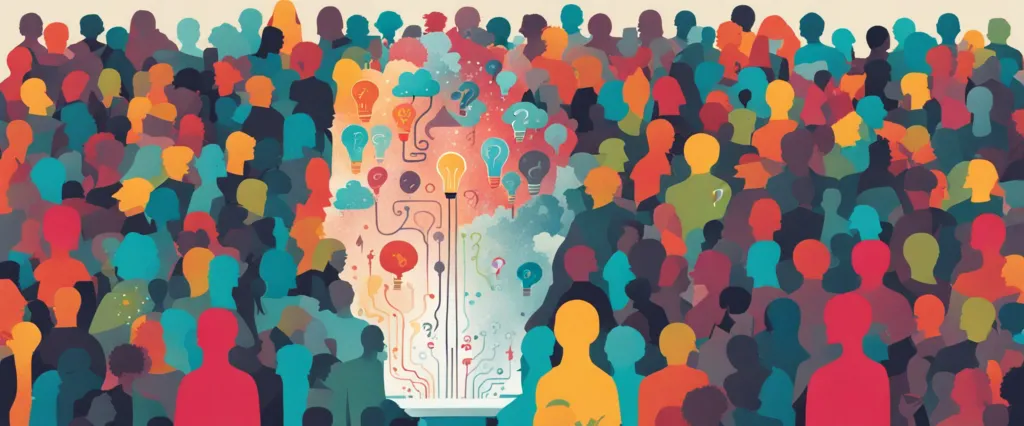In his thought-provoking book, “Invisible Influence,” acclaimed author Jonah Berger sheds light on the hidden power that shapes our daily decisions and behaviors. By delving into the fascinating realm of social influence, Berger explores how our choices are influenced by forces we often overlook or underestimate. With captivating anecdotes and compelling research, he uncovers the unseen impact of social factors on everything from the products we buy to the opinions we hold. As a renowned professor at the Wharton School and bestselling author of “Contagious,” Berger is praised for his deep understanding of social dynamics and his ability to communicate complex ideas in an engaging and accessible manner. In “Invisible Influence,” he once again captivates readers with his unique blend of insightful storytelling and illuminating analysis, encouraging us to rethink the way we perceive the world around us.
Chapter 1: The Hidden Forces of Influence: Unveiling the Power of Invisible Influence
In Chapter 1 of “Invisible Influence: The Hidden Forces of Influence: Unveiling the Power of Invisible Influence” by Jonah Berger, the author explores the concept of how our behavior is shaped by the influence of others even without our awareness. He challenges the commonly held belief that our choices are solely based on personal preferences and argues that unseen factors play a significant role in shaping our decisions and actions.
Berger introduces the concept of “The Smoky Room” to illustrate his point. He recounts an experiment where participants were unknowingly exposed to cues of attendance in a room filled with smoky odor. Despite not consciously perceiving the smell, those who were exposed to it were more likely to leave the experiment earlier than those in odorless rooms. This experiment demonstrates how our behavior can be unconsciously influenced by external factors.
The author also discusses the power of social proof, highlighting studies that show how observing others engaging in specific behaviors can significantly impact our own choices. People tend to conform to the actions of others, seeking validation and safety in numbers. Berger argues that this social proof can be a strong influencer in various aspects of life, from product choices to political opinions.
Additionally, Berger explores the impact of the “invisible hand” of behavior on our decision-making processes. He explains how the choices of others can shape our perception of what is popular and socially acceptable, resulting in a herd mentality where we prefer options that have already gained popularity.
In this opening chapter, Berger sets the foundation for the book’s exploration of unseen influences on our behavior. By bringing attention to the power of invisible influence, he encourages readers to be more aware of the factors that shape their decisions and how they can harness this knowledge to make more informed choices.
Chapter 2: Social Contagion: How Others Shape Our Thoughts and Behaviors
Chapter 2 of “Invisible Influence” by Jonah Berger discusses the concept of social contagion and how others can shape our thoughts and behaviors. Berger explores the idea that people are heavily influenced by the actions and opinions of those around them, often without even realizing it.
The chapter begins by examining the impact of social influence on our decision-making processes. Berger introduces the concept of conformity, where individuals tend to conform to the choices and behaviors of the majority. He explains how social proof, or the idea that people look to others for guidance when making decisions, is a powerful force in shaping our choices.
Furthermore, Berger highlights studies that show how social contagion can influence our emotions and behaviors. He presents research that demonstrates how emotions can be easily transmitted between individuals, leading to similar feelings and reactions within a social group. He also discusses how behaviors can be contagious, such as the spread of obesity or smoking habits among friends or family members.
Berger then delves into the idea of opinion leadership and influential individuals known as “opinion leaders,” who have a disproportionate impact on the thoughts and actions of others. These leaders possess the ability to sway public opinions and effectively shape societal attitudes.
To conclude the chapter, Berger emphasizes the importance of recognizing the influence of social contagion. By understanding how others shape our thoughts and behaviors, we can make more informed decisions and guard against blindly following the crowd. He also encourages individuals to embrace their role as influencers and consider how they can use their influence for positive change.
In summary, Chapter 2 of “Invisible Influence” explores the pervasive impact of social contagion on our thoughts and behaviors. Through the concept of conformity, social proof, contagious emotions and behaviors, and the influence of opinion leaders, Berger emphasizes the significant role that others play in shaping our decision-making processes and overall behavior.
Chapter 3: The Science of Conformity: Understanding the Urge to Fit In
Chapter 3 of the book “Invisible Influence” by Jonah Berger is titled “The Science of Conformity: Understanding the Urge to Fit In.” In this chapter, Berger explores the concept of conformity and how it profoundly influences our behavior and decision-making processes.
Berger starts by presenting various studies that demonstrate how our desire to fit in can lead us to conform to the behavior of others. He explains that conformity occurs when individuals change their beliefs, thoughts, or actions in order to match those of a larger group or societal norm. Berger delves into the psychological principles behind this, including social comparison theory and informational conformity, which suggest that people conform due to a desire for accuracy or belonging.
The chapter also explores the concept of normative conformity, which is when individuals conform to gain social acceptance and avoid rejection or punishment. Berger highlights that conformity can be both conscious and unconscious, occurring in various areas of our lives, including fashion choices, consumer behavior, and social media trends.
Furthermore, the chapter discusses the influence of group dynamics on conformity. Berger illustrates how even when individuals are aware of a better choice or higher-quality option, they often conform to the group’s preference to avoid going against the majority.
Overall, Chapter 3 of “Invisible Influence” provides a comprehensive understanding of the science behind conformity and the urge to fit in. By examining various studies and psychological theories, Berger emphasizes the power of social influence and the mechanisms through which conformity affects our decision-making processes.
Chapter 4: Word of Mouth and Social Proof: Harnessing the Influence of Others

Chapter 4 of “Invisible Influence” by Jonah Berger explores the power of word of mouth and social proof in shaping people’s behaviors and decisions. Berger delves into why individuals rely on the opinions and actions of others, and how this influence can drive our own choices.
The chapter begins by discussing the impact of word of mouth, highlighting its significant role as a form of social influence. Berger emphasizes that we trust the opinions and recommendations of people we know more than any advertisement or expert advice. Word of mouth spreads, and when a product or idea is recommended by someone close to us, we are more likely to adopt it due to the perceived reliability and authenticity.
Berger also introduces the concept of social proof, which refers to the tendency of individuals to look to others when unsure how to act. He explains how people often mimic the behavior of those around them, especially in uncertain situations, as it provides a sense of security and conformity. Social proof can be seen in various contexts, such as individuals imitating the actions of others during emergencies or conforming to social norms.
The author further explores the factors that enhance the impact of social proof. He explains that the influence is stronger when we perceive others to be similar to us or when we observe multiple people engaging in a particular behavior. Additionally, Berger notes that conformity can be driven by both informational and normative influences, where people either seek guidance or want to be accepted by their peers.
Overall, Chapter 4 sheds light on how word of mouth and social proof profoundly affect our decision-making and behavior. The influence of those around us, whether through recommendations or actions, shapes our attitudes, preferences, and actions, ultimately guiding our choices.
Chapter 5: The Power of Context: How Environments Shape Our Decisions
Chapter 5 of Jonah Berger’s book “Invisible Influence” is titled “The Power of Context: How Environments Shape Our Decisions.” In this chapter, Berger explores the influence of our surroundings and the role they play in shaping our behavior and decision-making.
Berger begins by discussing the concept of priming, which refers to the way our environment can activate certain thoughts and influence our behavior without us realizing it. He presents multiple studies and experiments that highlight the significance of this phenomenon. For example, research has found that individuals in a clean environment tend to exhibit more ethical behavior compared to those in a messy environment.
Next, Berger explores how the choices made by others in our environment impact our decisions. He introduces the concept of social comparison, explaining that people are more likely to conform to the behavior of those around them. He provides examples such as restaurant tip percentages being influenced by the behavior of previous customers, as well as the influence of crowd behavior on individual actions.
Berger also delves into the power of social norms, explaining that they guide our decision-making process and shape our behavior. He discusses studies that demonstrate how individuals tend to conform to societal norms, even if they may disagree with them. People have a strong desire for social approval and as a result, they often adapt to the expectations presented by their environment.
Furthermore, Berger highlights the important role that subtle cues within our environment have on our behavior. He explains how small changes, such as the background music in a store or the scent in a room, can significantly impact our decision-making and purchasing choices.
Overall, in Chapter 5 of “Invisible Influence,” Berger emphasizes that the power of context is pervasive and influential. Our behavior and decisions are constantly shaped by our surroundings, whether we are aware of it or not. Understanding this influence can help us make better choices while also shedding light on the subtle ways in which our environment can shape our behavior.
Chapter 6: The Art of Persuasion: Techniques for Effective Influence
Chapter 6 of the book “Invisible Influence” by Jonah Berger explores the art of persuasion and the techniques for effective influence. Berger begins by emphasizing the importance of understanding others’ emotions and motivations when trying to persuade them. He explains that people are more likely to be influenced when they feel emotionally connected to the message being conveyed.
One powerful technique Berger highlights is “liking.” He elaborates on the influence of similarity and commonality, stating that people are more easily persuaded by those they perceive as similar to themselves. By finding common ground and showcasing shared interests or backgrounds, persuaders can increase their chances of successfully influencing others.
Berger also discusses the power of social proof, which is the tendency to rely on the actions and opinions of others when making decisions. By utilizing testimonials, reviews, or endorsements, persuaders can activate the social proof phenomenon and boost their persuasive efforts.
Furthermore, scarcity is another technique that holds influence. People tend to value things that are rare or limited, and therefore, creating a sense of scarcity can enhance persuasiveness. Berger provides examples of how highlighting the uniqueness or exclusivity of a product or opportunity can trigger a desire to possess or be a part of it.
Lastly, Berger explores the concept of authority in persuasion. People are prone to be influenced by figures they perceive as experts or knowledgeable in a certain domain. By leveraging authority and credibility, persuaders can enhance their message’s impact.
Overall, Chapter 6 of “Invisible Influence” uncovers various techniques for effective persuasion, including likability, social proof, scarcity, and authority. By understanding and harnessing these techniques, individuals can become more successful in influencing others to adopt their desired perspectives and behaviors.
Chapter 7: The Role of Identity: How Our Beliefs and Values Drive Influence
Chapter 7: The Role of Identity: How Our Beliefs and Values Drive Influence of the book Invisible Influence by Jonah Berger focuses on the powerful role that identity plays in shaping our behavior and decision-making. Berger delves into the concept of social identity and how it impacts our actions in various social contexts.
Berger begins by highlighting that our identities are an essential part of who we are, as they shape our beliefs, values, and affiliations. He explains that when our identity is threatened, we tend to become defensive, more resistant to change, and more supportive of ideas and individuals who align with our identity.
Furthermore, Berger introduces the concept of “identity signaling,” which refers to the ways in which individuals use their choices, behaviors, and associations to signal their values and beliefs. He argues that we often make decisions based on how they align with our desired identity, seeking to project a certain image to ourselves and others.
The chapter also explores how social influences subtly shape our identities. Berger cites studies that demonstrate how our behavior adapts to fit in with certain groups, even unconscious mimicking of others’ actions or preferences. He explains that this mirroring behavior helps establish a sense of similarity and connection, which reinforces our social identities.
Berger further examines the influence of social proof, emphasizing that people are more likely to adopt certain beliefs or actions if they see others who share their identity doing the same. He illustrates this phenomenon through examples such as political activism, where an individual seeing large crowds of like-minded individuals can drive their own engagement.
Overall, Chapter 7 emphasizes the pivotal role that identity plays in influencing our choices, beliefs, and behaviors. It highlights how our desire for social acceptance and alignment with our identity drives us to make decisions and seek out information that confirms our existing beliefs.

Chapter 8: Resisting Influence: Navigating the Complexities of Invisible Forces
Chapter 8 of “Invisible Influence” by Jonah Berger explores the topic of resisting influence and how to navigate the complexities of invisible forces in our daily lives. Berger highlights the various factors that contribute to our susceptibility to influence, and provides strategies to overcome them.
The chapter begins by discussing the power of social norms and how they shape our behavior. Berger explains that we tend to conform to the actions and opinions of others around us, even if we may not necessarily agree with them. He emphasizes the importance of being aware of this tendency and actively resisting the influence of social norms when they conflict with our own values and beliefs.
Next, Berger delves into the concept of reactance, which refers to our natural inclination to resist persuasion and maintain our autonomy. He explains that when we feel our freedom is being threatened, we are more likely to resist influence. Berger suggests that understanding this reaction can help us make better decisions by considering the underlying factors that might be driving our resistance.
Berger then explores the notion of persuasion and the power of repetition. He highlights that repetition can create familiarity and likeability, which in turn can influence our opinions and behavior. To resist this form of influence, Berger proposes building our resistance muscles by actively seeking out diverse perspectives and challenging our own biases.
Lastly, the chapter discusses the importance of self-awareness in resisting influence. Berger encourages readers to reflect on their values, goals, and motivations to better understand their susceptibility to influence. By aligning their actions with their true selves, individuals can resist the invisible forces that push them towards conformity.
In summary, Chapter 8 of “Invisible Influence” delves into the complexities of resisting influence. Berger provides insights and strategies for navigating the invisible forces that shape our decisions and behaviors, including understanding social norms, recognizing reactance, overcoming the power of repetition, and cultivating self-awareness. By actively resisting influence, individuals can make more independent and authentic choices in their lives.
After Reading
In conclusion, the book “Invisible Influence” by Jonah Berger provides valuable insights into the impactful role of social influence in shaping our choices and behaviors. Berger explores numerous examples and studies to emphasize how our decisions are often influenced by subtle factors that we are not aware of. By understanding the nuances of social influence and recognizing its presence in our lives, we can gain better control over our actions and make more informed choices. Ultimately, Berger empowers readers with knowledge on how to navigate the invisible forces that shape their lives, enabling them to become more independent thinkers and make decisions aligned with their own values and goals.
1. “Contagious: How to Build Word of Mouth in the Digital Age” by Jonah Berger – If you enjoyed “Invisible Influence,” you’ll likely find “Contagious” just as intriguing. Berger explores the factors that make certain ideas, products, or behaviors go viral, helping readers understand how to create contagious content and generate buzz.
2. The Power of Habit: Why We Do What We Do in Life and Business” by Charles Duhigg – This book delves into the science behind habits and explores the influence they have on our lives. Duhigg presents real-life stories and research, illustrating how understanding and harnessing the power of habits can lead to personal and professional transformation.
3. Influence: The Psychology of Persuasion” by Robert B. Cialdini – This classic explores the psychology of persuasion and how people can be influenced to say “yes.” Cialdini discusses various principles of influence, backed by numerous studies and examples, providing readers with valuable insights into the psychology behind decision-making and compliance.
4. Nudge: Improving Decisions About Health, Wealth, and Happiness” by Richard H. Thaler and Cass R. Sunstein – Combining behavioral economics and psychology, this book explores how small changes or “nudges” can significantly impact people’s behavior and decisions. Thaler and Sunstein offer suggestions on creating environments that can positively influence individuals towards making better choices.
5. Predictably Irrational: The Hidden Forces That Shape Our Decisions” by Dan Ariely – In this captivating read, Ariely explores the irrationalities that influence and guide our decision-making processes. Delving into behavioral economics, the author uncovers the hidden forces that drive our choices and examines their consequences, offering practical insights for understanding our own behavior and that of others.
These five books cover a range of topics related to influence, persuasion, habits, decision-making, and behavioral economics, offering a compelling reading list for anyone interested in understanding the invisible factors that shape our choices and behaviors.




